|
|
|
Sort Order |
|
|
|
Items / Page
|
|
|
|
|
|
|
| Srl | Item |
| 1 |
ID:
170340
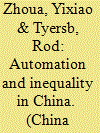

|
|
|
|
|
| Summary/Abstract |
In transitional economies, low wages imply sub-OECD yet growing labor shares of value added. China's rapid development has, however, seen a declining low-skill labor share and rising inequality. Here, a stylized model with three households and separable TFP and factor bias suggests a third of the decline in the low-skill share since 1994 is due to structural change and the rest mainly to skill-biased technical change. Expected future twists away from low-skill labor toward capital yield further inequality, moderated if strong TFP growth and population stability continue. But if the bias accompanies TFP shortfalls, worker displacement and rising inequality are in prospect.
|
|
|
|
|
|
|
|
|
|
|
|
|
|
|
|
| 2 |
ID:
121547
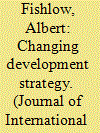

|
|
|
|
|
| Publication |
2013.
|
| Summary/Abstract |
Latin America experienced high rates of growth in the first decade of the twenty-first century. Will the region-increasingly split into Atlantic and Pacific countries with different policies-be able to continue this pace into the future? That will depend upon high rates of investment, regulatory stability, and openness to technological advancement to sustain gains in productivity and permit continued improvements in income distribution.
|
|
|
|
|
|
|
|
|
|
|
|
|
|
|
|
| 3 |
ID:
097824
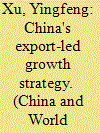

|
|
|
|
|
| Publication |
2010.
|
| Summary/Abstract |
A pressing challenge for China is determining where to accommodate millions of migrant workers displaced by the closing of many export-oriented factories. The current global financial crisis has exposed the fragility of the export-led growth strategy China has adopted over the past 30 years. Is there a better alternative for providing non-agricultural jobs than the sweatshops of cheap export production? In the present paper, international experience is reviewed to shed light on China's situation. Using pooled regression models, we analyze data from the World Bank for 209 economies. We investigate the experience of other economies to answer the following questions: What is the common process of expanding the non-agricultural economy? How is that process affected by the level of the real exchange rate? Is export production a common way of absorbing surplus rural labor? Finally, what are the ways that domestic demand and service employment can be expanded?
|
|
|
|
|
|
|
|
|
|
|
|
|
|
|
|
| 4 |
ID:
092526
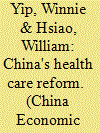

|
|
|
|
|
| Publication |
2009.
|
| Summary/Abstract |
China has recently unveiled an ambitious new health-care reform plan, entailing a doubling of government health spending as well as a number of concrete reforms. While the details of the plan have not yet been completely announced, we offer a preliminary assessment of how well the reform is likely to achieve its stated goal of assuring every citizen equal access to affordable basic health care. The reform is based on three fundamental tenets: strong role of government in health, commitment to equity, and willingness to experiment with regulated market approaches. Within this framework, the reform offers a number of laudable changes to the health system, including an increase in public health financing, an expansion of primary health facilities and an increase in subsidies to achieve universal insurance coverage. However, it fails to address the root causes of the wastes and inefficiencies plaguing China's health care system, such as a fragmented delivery system and provider incentives to over-provide expensive tests and services. We conclude that China should consider changing the provider payment method from fee-for-service to a prospective payment method such as DRG or capitation with pay-for-performance, and to develop purchasing agencies that represent the interests of the population so as to enhance competition.
|
|
|
|
|
|
|
|
|
|
|
|
|
|
|
|
| 5 |
ID:
181843
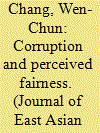

|
|
|
|
|
| Summary/Abstract |
Corruption can erode political trust and a well-functioning democratic system, but it is unclear whether perceptions of corruption are significantly associated with citizens’ perceptions about the fairness of income distribution. This study thus examines the role of political trust in shaping the relationship between perceptions of corruption and perceived fairness of income distribution for East Asian countries. The findings show that perceived corruption has strong detrimental effects on political trust, and that those who have lower levels of political trust are more likely to perceive the income distribution as unfair in their countries. Causal mediation analysis results indicate that political trust plays an important role in mediating the negative effect of perceived corruption on perceived fairness of income distribution. Moreover, the results from examining the mutual causality linking corruption, political trust, and perceived fairness suggest that the reciprocal causal effects are also significant and robust.
|
|
|
|
|
|
|
|
|
|
|
|
|
|
|
|
| 6 |
ID:
106231


|
|
|
|
|
| Publication |
2011.
|
| Summary/Abstract |
This study examines changes in Chinese urban income distribution from 1987 to 1996 and 1996 to 2004 using nationwide household data and investigates the causes of these changes. The Firpo, Fortin, and Lemieux (2007, 2009) method based on unconditional quantile regressions is used to decompose changes in income distribution and income inequality measures, such as variance and a 10:90 ratio. The decomposition results show that wage structure effects, such as a widening gender earnings gap, increases in returns to college education, and increases in earnings differentials between industries, company ownership types, and regions, have been the major contributors to the overall increases in income inequality. It was also found that at different points on the income distribution (e.g., the lower or upper half), the contributing factors that increase income inequality are different.
|
|
|
|
|
|
|
|
|
|
|
|
|
|
|
|
| 7 |
ID:
165418


|
|
|
|
|
| Summary/Abstract |
Despite strong theoretical reasons to expect that democratization equalizes income distributions, existing empirical studies do not find a statistically significant effect of democratization on measures of income inequality. This paper starts from the simple observation that autocracies are heterogeneous and govern quite extreme distributional outcomes (also egalitarian). Democratization may drive extreme income distributions to a “middle ground.” We thus examine the extent to which initial inequality levels determine the path of distributional dynamics following democratization. Using fixed-effects and instrumental variable regressions, we demonstrate that egalitarian autocracies become more unequal following democratization, whereas democratization has an equalizing effect in highly unequal autocracies. The effect appears to be driven by changes in gross (market) inequality, suggesting that democratization has led, on average, to redistribution of market opportunities, rather than to direct fiscal redistribution. We then investigate which kinds of (heterogeneous) reforms are at work following democratizations that may rationalize our findings.
|
|
|
|
|
|
|
|
|
|
|
|
|
|
|
|
| 8 |
ID:
132611
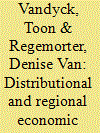

|
|
|
|
|
| Publication |
2014.
|
| Summary/Abstract |
We analyse the macroeconomic and distributional effects of increased oil excises in Belgium by combining a regional Computable General Equilibrium (CGE) model with a microsimulation framework that exploits the rich detail of household-level data. The link between the CGE model and the microlevel is top-down, feeding changes in commodity prices, factor returns and employment by sector into a microsimulation model. The results suggest that policymakers face an equity-efficiency trade-off driven by the choice of revenue recycling options. When the additional revenue is used to raise welfare transfers to households, the reform is beneficial for lower income groups, but output levels decrease in all regions. However, when the energy tax revenue is used to lower distortionary labour taxes, the tax shift is slightly regressive. In this case, national GDP is hardly affected but regional production levels diverge. The impact of the environmental tax reform on income distribution depends strongly on changes in factor prices and welfare payments, whereas sector composition is an important determinant for regional impact variation.
|
|
|
|
|
|
|
|
|
|
|
|
|
|
|
|
| 9 |
ID:
166486


|
|
|
|
|
| Summary/Abstract |
Using annual data from 1980 to 2014, the study explores the relationship between carbon emissions and skewed pattern of income distribution among 4 selected BRICS economies (e.g. Brazil, India, China and South Africa). Using Quantile-on-Quantile regression (QQR) technique of Sim and Zhou (2015), it tries to contribute towards an empirical understanding on the quantile structure of both the variables for the selected BRICS countries. It finds for India and Brazil that as income rises, although both lower and upper income people degrade the environmental quality by releasing more CO2 emissions but interestingly, it is the poor who intensively degrade the environmental quality than the rich. In sharp contrast, for China and South Africa, it finds that it is the poor who relatively contribute less to the environmental degradation by reducing CO2 emissions than the rich. These findings have greater policy significances which are discussed at the concluding section in greater detail.
|
|
|
|
|
|
|
|
|
|
|
|
|
|
|
|
| 10 |
ID:
029220


|
|
|
|
|
| Publication |
New York, United Nations., 1969.
|
| Description |
iv, 269p.
|
|
|
|
|
|
|
|
|
|
|
|
Copies: C:1/I:0,R:0,Q:0
Circulation
| Accession# | Call# | Current Location | Status | Policy | Location |
| 012317 | 339.20982/UNI 012317 | Main | On Shelf | General | |
|
|
|
|
| 11 |
ID:
192232
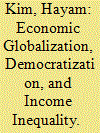

|
|
|
|
|
| Summary/Abstract |
In the last 40 years, East Asian countries have undergone significant economic and political transformation, with deepening integration into the world economy and substantial progress toward democracy. I investigate the impact of these two major developments on income distribution in East Asia. This study extends prior research by (1) examining the role of both international economic and domestic political factors, topics that have mostly been studied separately; (2) employing inequality data that are more complete than those used in previous studies; and (3) using data for a period during which the pace of globalization greatly accelerated, a major relevant event (the Asian financial crisis) occurred, and several countries in the region witnessed a considerable expansion of democratic rights. Evidence for the claim that trade increases inequality is robust, but empirical support for the redistributive effects of both foreign direct investment and democracy is weak.
|
|
|
|
|
|
|
|
|
|
|
|
|
|
|
|
| 12 |
ID:
024311
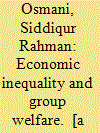

|
|
|
|
|
| Publication |
Oxford, Clarendon Press, 1982.
|
| Description |
viii, 179p.
|
| Standard Number |
019828425X
|
|
|
|
|
|
|
|
|
|
|
|
Copies: C:1/I:0,R:0,Q:0
Circulation
| Accession# | Call# | Current Location | Status | Policy | Location |
| 020790 | 339.2095492/USM 020790 | Main | On Shelf | General | |
|
|
|
|
| 13 |
ID:
166393


|
|
|
|
|
| Summary/Abstract |
This paper evaluates the economy-wide effects of carbon taxation in China. To this end, we build a price model based on an energy input-output table in hybrid units that ensures the consistency of the analysis. The results indicate that carbon taxation has small negative impact on GDP. There are, however, relatively substantial emissions reductions. To explore whether the impacts are spatially blind, in the sense of having similar impacts on urban and rural residents, the results of the distributional effects show that the impacts of carbon taxation on different urban household groups reveal small differences and are slightly regressive. Yet for rural residents, carbon taxation may be significantly regressive. In addition, rural residents are found to be affected much more than urban residents. Furthermore, the paper explores a policy intervention to investigate the effects of redistributing the carbon tax paid by households. The main results reveal that reallocating the carbon tax to the groups with low income levels can offset the negative distributional effects significantly. Moreover, the results of Miyazawa-style interrelational income multiplier analysis indicate that the household groups with high income would benefit significantly from the income increases in those with low income levels, but not vice versa.
|
|
|
|
|
|
|
|
|
|
|
|
|
|
|
|
| 14 |
ID:
177152
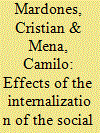

|
|
|
|
|
| Summary/Abstract |
In 2017, environmental taxes on global pollutants (CO2) and local air pollutants (SO2, NOX, and PM) began to be collected to reduce emissions in Chile. However, large emitting sources only are subject to environmental taxes and the tax rates are much lower than the social cost of these pollutants, which does not allow to fully internalize the generated damages. For the above, this study uses the environmental extension of the Leontief price model and microsimulations to estimate the economic, environmental, distributive, and poverty short-term effects associated with the application of Pigouvian taxes on all emissions generated by productive activities. The results show that currently there are too many resources allocated to activities that generate strong negative externalities, mainly in the electricity and transport sectors. Specifically, the emissions are reduced almost 10 times more than in the current tax scenario if environmental taxes equal to social costs are applied, but relevant negative indirect effects are generated that make the practical application of a tax of these characteristics unrealistic. For example, there is a fall between 1.2% and 2.9% in employment, slightly worsening the income distribution and increases the poverty rate between 0.9 and 2.3 percentage points.
|
|
|
|
|
|
|
|
|
|
|
|
|
|
|
|
| 15 |
ID:
102767


|
|
|
|
|
| Publication |
2011.
|
| Summary/Abstract |
This paper examines the contribution of exports to growth in China since the early years of the decade. It is estimated that, despite a high import content ranging between 40 and 50 percent, approximately one-third of Chinese growth before the global crisis was a result of exports, due to their phenomenal growth of some 25 percent per annum. This figure increases to 50 percent if spillovers to consumption and investment are allowed for. The main reason for excessive dependence on foreign markets is underconsumption. This is due not so much to a high share of household savings in GDP as to a low share of household income and a high share of profits. It is argued that China can no longer maintain such high growth rates for its exports, and, therefore, needs to turn to consumption-led growth by expanding the share of wages and household income in GDP and accelerating public spending in social infrastructure.
|
|
|
|
|
|
|
|
|
|
|
|
|
|
|
|
| 16 |
ID:
158908


|
|
|
|
|
| Summary/Abstract |
In the post‐reform era, China achieved poverty reduction that was unprecedented in human history This poverty reduction was accompanied by fast growth and worsening income distribution. The present paper examines the poverty–growth–inequality triangle in China by: (i) providing growth, inequality and poverty profiles at the national and provincial levels; (ii) uncovering the contributions of growth and inequality changes to poverty reduction; and, finally, (iii) drawing lessons for other developing countries. Based on the World Bank's definition of the poverty line, China has already eliminated abject poverty, even though the poverty rate was as high as 88.3 percent in 1981. The remarkable record in poverty reduction is predominantly attributable to growth. The effect of inequality varied in different periods. In addition, the impact of growth on poverty reduction is found to be diminishing over time, a phenomenon worth further research and policy attention.
|
|
|
|
|
|
|
|
|
|
|
|
|
|
|
|
| 17 |
ID:
082718


|
|
|
|
|
| Publication |
London, Routledge, 2008.
|
| Description |
106p.
|
| Series |
RUSI whitehall paper 70
|
|
|
|
|
|
|
|
|
|
|
|
Copies: C:1/I:0,R:0,Q:0
Circulation
| Accession# | Call# | Current Location | Status | Policy | Location |
| 053304 | 355.033541/CHA 053304 | Main | On Shelf | General | |
|
|
|
|
| 18 |
ID:
116947


|
|
|
|
|
| Publication |
2012.
|
| Summary/Abstract |
Natural resource revenues differ from other government revenues both in their time profile, and in their political and legal status: they are volatile and exhaustible, and belong to all citizens of the country in which they are located. This paper discusses the theory of natural resource revenues and examines expenditure practices in a range of resource-rich countries. It considers both the distributional impact and the efficiency of expenditure policies, focusing on the extent to which they succeed in providing all citizens with their share of the benefits due to natural resources.
|
|
|
|
|
|
|
|
|
|
|
|
|
|
|
|
| 19 |
ID:
132652


|
|
|
|
|
| Publication |
2014.
|
| Summary/Abstract |
The petroleum sector contributes substantially to the Nigerian economy; however, the potential benefits are diminished due to the existence of significant subsidies on imports of petroleum products. Subsidies on imported petroleum products are considered to be an important instrument for keeping fuel prices, and hence the cost of living, low. The costs of these subsidies, however, has risen dramatically in recent years due to increased volatility in world petroleum and petroleum product prices and increased illegal exportation of subsidized petroleum products into neighboring countries. Removing the subsidy on fuel is one of the most contentious socio-economic policy issues in Nigeria today. In this paper, an economy-wide framework is used to identify the impact of removing the fuel subsidy on the Nigerian economy and investigates how alternative policies might be used to meet socio-economic objectives related to fuel subsidies. The results show that while a reduction in the subsidy generally results in an increase in Nigerian GDP, it can have a detrimental impact on household income, and in particular on poor households. Accompanying the subsidy reduction with income transfers aimed at poor households or domestic production of petroleum products can alleviate the negative impacts on household income.
|
|
|
|
|
|
|
|
|
|
|
|
|
|
|
|
| 20 |
ID:
040939


|
|
|
|
|
| Publication |
New York, New York University Press, 1958.
|
| Description |
xiv, 153p.
|
|
|
|
|
|
|
|
|
|
|
|
Copies: C:1/I:0,R:0,Q:0
Circulation
| Accession# | Call# | Current Location | Status | Policy | Location |
| 001129 | 339.32/STU 001129 | Main | On Shelf | General | |
|
|
|
|
|
|
|
|
|